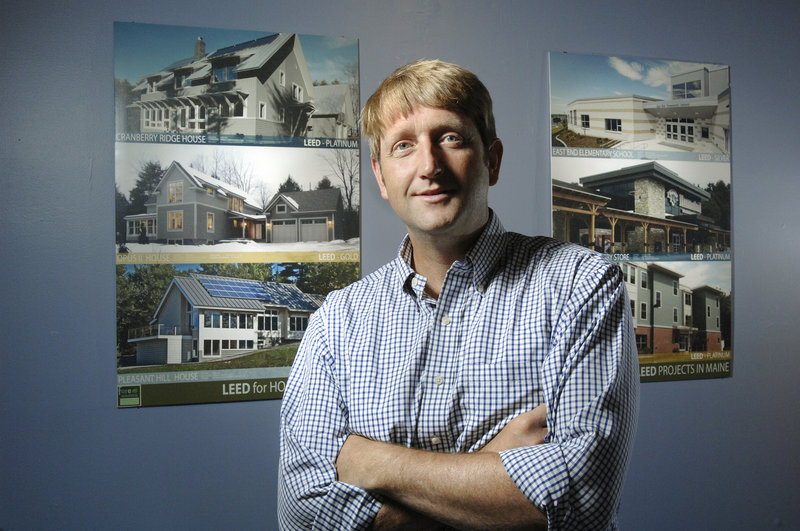PORTLAND – The dry, desert air in the Saudi Arabian capital of Riyadh can swing 50 degrees from day to night. Designing a comfortable building that uses way less energy in the harsh climate is a challenge. One idea is to take some hints from how plants and ancient people survived.
That thinking led Fore Solutions, a green building consultant in Portland, to suggest strategies that incorporate natural ventilation, thermal mass and indirect daylight into the Museum for the Built Environment, now rising in the King Abdullah Financial District.
It’s the sort of thinking that has propelled Fore Solutions and its architect founder, Gunnar Hubbard, from a one-man shop with local clients in 2003, to a 10-person firm that’s earning roughly a quarter of its revenue overseas.
Hidden away on the fourth floor above an Old Port storefront, Fore Solutions isn’t widely recognized in its hometown. But it’s making a name in the exploding world of green building and sustainable architecture, consulting on high-profile projects from Las Vegas to Maine, as well as China and Dubai.
Success is coming from a combination of good skills, strong connections and fortunate timing, as the global demand for green building expertise grows and evolves.
In Saudi Arabia, Fore Solutions has been working as a sunstainability consultant for FX Fowle, a New York City achitecture firm that designed the 340,000-square-foot museum. Partly clad in prismatic, laminated panels, the look was inspired by ancient cities in the Saudi desert.
But FX Fowle also wanted 21st-century performance. It wanted a museum that uses half the energy allowed by building codes and meets the U.S. Green Building Council’s LEED-Silver certification.
“We helped the design team improve the performance of the building,” said Vamshi Gooje, a project manager and energy analyst at Fore Solutions.
One tool was sun studies. Riyadh bakes in the sun, but the museum is surrounded by tall buildings that cast long shadows on the site in winter, except on the west side. Gooje and Colin Schless, another energy analyst, helped devise options that take advantage of natural light — such as an east-facing clerestory and a light shaft to help illuminate a four-story underground parking garage.
They also calculated how the building’s mass could be ventilated with cooler air at night, and how warm air could be exhausted through a stack tower and giant atrium. These techniques are used by nature and man to regulate temperature in the desert — by the window plant, which has leaves buried in the soil, and by ancient civilizations that built massive stone walls punctuated with openings for daylight.
Not all these concepts translate. An idea of spraying water inside a tower to cool hot, dry air was rejected because of fears of moisture in the museum. Natural ventilation would cut electricity use, but desert dust storms could blow fine particles into the galleries. A mix of filters and fans may be needed, Gooje said.
“They’re not completely sold on this idea,” he said.
Fore Solutions currently is working on a project in Shanghai, China. It has done energy analysis for an 857,000-square- foot financial center in Dubai, which currently is on hold for economic reasons. It performed consulting for four buildings that earned LEED-Gold certification at the MGM Mirage, City Center complex in Las Vegas, the country’s largest, privately funded construction project.
Closer to home, Fore Solutions helped Hannaford’s new supermarket in Augusta earn a LEED-Platinum certification. It also worked on the new “net-zero energy” education center at the Coastal Maine Botanical Garden, designed to produce as much energy over a year as it consumes. The firm also acted as the LEED consultant for transforming the former Portland Public Market into the headquarters for PowerPay.
This range of work shows how Fore Solutions has carved out a unique niche in Maine, according to Katye Charette, executive director of the Maine chapter of the U.S. Green Building Council. Hubbard is an entrepreneur with global connections and a deep knowledge of sustainable building practices, she said. It’s a combination that lets a small firm partner with big players on high-profile projects.
“It takes confidence,” she said. “They take big risks by engaging in work in countries that have different ways of building and doing business.”
These landmark projects get noticed, Charette said, but there’s also a flood of potential work in rehabilitating existing buildings to high-performance standards, especially in places such as Maine.
“We’ve got the oldest building stock in the country and it needs help,” she said.
Staff Writer Tux Turkel can be contacted at 791-6462 or at:
tturkel@pressherald.com
Send questions/comments to the editors.




Success. Please wait for the page to reload. If the page does not reload within 5 seconds, please refresh the page.
Enter your email and password to access comments.
Hi, to comment on stories you must . This profile is in addition to your subscription and website login.
Already have a commenting profile? .
Invalid username/password.
Please check your email to confirm and complete your registration.
Only subscribers are eligible to post comments. Please subscribe or login first for digital access. Here’s why.
Use the form below to reset your password. When you've submitted your account email, we will send an email with a reset code.